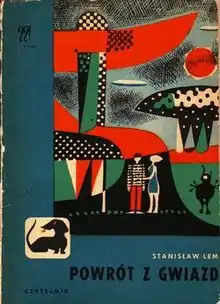Return from the Stars
Return from the Stars (Polish: Powrót z gwiazd) is a science fiction novel by Polish author Stanisław Lem. Written in 1961, it is the story of a cosmonaut returning to his homeworld, Earth, after more than a century in Earth time, but just 10 years for him, finding it a completely different place, with no place for him. The novel touches the ideas of social alienation, culture shock and dystopia. It was first translated into English in 1980 by Barbara Marszal and Frank Simpson.
 First edition | |
| Author | Stanisław Lem |
|---|---|
| Original title | Powrót z gwiazd |
| Cover artist | Marian Stachurski |
| Country | Poland |
| Language | Polish |
| Genre | Science fiction |
| Publisher | Czytelnik (first Polish edition) Harcourt Brace Jovanovich (first English edition) |
Publication date | 1961 |
Published in English | 1980 |
| Media type | Print (Hardcover & Paperback) |
| Pages | 247 (first English edition) |
| ISBN | 0-15-177082-4 (first English edition) |
| OCLC | 5940875 |
| 891./537 | |
| LC Class | PZ4.L537 Re PG7158.L39 |
Plot summary
The novel tells the story of an astronaut, Hal Bregg, who returns to Earth after a mission to Fomalhaut during which the Earth passed through 127 years of proper time.[1] Due to time dilation, the mission has lasted only 10 years for him. On Earth he faces culture shock, as he finds the society transformed into a utopia, free of wars or violence, or even accidents.
For Hal, however, this new world is too comfortable, too safe. Earth is no longer home, it is "another, alien planet". Humans themselves have changed, having undergone a procedure called betrization, designed to neutralize all aggressive impulses. Its side effect is an extreme aversion to risk.[2] Hal mistrusts this approach, seeing it as wrong. In particular, for an astronaut, he cannot agree with the opinion that space travel and space exploration are nothing but a youthful and dangerous adventurism. For Hal, this means that "...they have killed the man in man". He and the other returning astronauts are viewed with mistrust, seen as "resuscitated Neanderthals". They are alienated, outcasts, and subject to social pressure to undertake the betrization. The other choice is to leave Earth again and hope that once they come back, in several centuries, Earth's society is more familiar again.
In time, Hal marries a local girl, Eri, and comes to see the world her way, even disapproving of his youth's love, space expeditions. When he learns that members of his former crew are planning a mission to Sagittarius, he seems not to care, content to leave the stars to others. Hal still remembers his past, recalls the moon Kereneia, a magnificent canyon "made of red and pink gold, almost completely transparent...through it you can see all the strata, geological folds, anticlines and synclines...all this is weightless, floating and seeming to smile at you". Yet he trades the chance to experience such sights and adventures for love and a peaceful, quiet life.
Major themes
Return from the Stars is one of Lem's several works focusing on utopia. Out of those, it is the least pessimistic about the consequences of technological progress and their effect on our sociocultural evolution. Even so, the depicted world is not perfect: in a pacified society, with no conflict, stress, and danger, Lem argues that humans will become unable to take any risks, to take initiative, commit themselves to any serious tasks, and even lose the ability for self-assertion and for feeling strong emotions. Return from the Stars asks whether some sociocultural advances, like peace, are worth the price we may pay for losing part of our nature.
Lem predicts the disappearance of paper books from the society. Lem even describes a reading device very much like a tablet computer that the main character Hal Bregg gets familiar with when he tries to find paper books and newspapers. The novel also anticipates electronic paper and tablet computers with "Opton".
Reception
Lem himself judged the novel as unsuccessful, because the centrepiece idea of the plot, elimination of social evil, is treated in a simplistic way.[3] The theme would find much more thorough attention in Lem's 1982 novel Observation on the Spot.
Aleksander Ford wanted to direct the film based on the novel, but he wanted a large-budget film and failed to find investors.[4]
Notes
- Arcturus in the English translation
- Jerzy Jarzębski, "Stanislaw Lem, Rationalist and Visionary", Science Fiction Studies, Vol. 4, part 2, No. 12, July 1977
- Stanisław Lem, Mein Leben ("My Life"), Berlin, 1983
- Łukasz Maciejewski,"Święty spokój", an interview with Lem
References
- Return from the Stars, Official English page of the book
- Peter Swirski, "Betrization Is the Worst Solution... With the Exception of All Others." The Art and Science of Stanislaw Lem. Edited by Peter Swirski. Montreal, London: McGill-Queen's UP, 2006.
- Marilyn Jurich, The pseudo-utopian cosmographies of Stanislaw Lem, Utopian Studies, 1998, Vol. 9, Issue 2, ISSN 1045-991X
External links
- Return from the Stars title listing at the Internet Speculative Fiction Database
- Станислав Лем, Возвращение со звёзд, Russian publications at fantlab.ru
